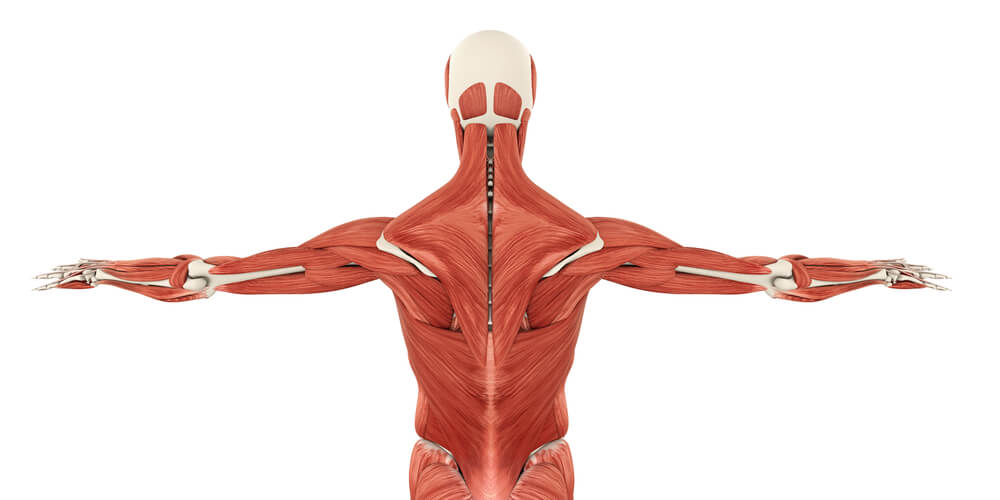
Everyone loves to work the noticeable muscles. The chest press to build a stronger chest, The military press to work those shoulders and all sorts of curls to build t-shirt ripping guns. But what about the back? Sometimes the back misses out on important lifts.
Sometimes it’s just out of sight, out of mind. And while you do work the back on chest day (especially if your life for tension and slow your reverse movement) it is important to really target the back if you want to see both strength and size gains.
The beauty of building the strength and size in your back is your chest and shoulder exercises will improve as well. There are plenty of back lifts you can focus on to build eye-popping muscles, you just need to know what to target, which each lift targets and how to go about lifting for gains.
Thankfully, that’s exactly what we have to offer you right here.
Muscles In the Back
When you really want to get technical there are dozens of different kinds of muscles in the back.
Most of the major muscles are broken down into three four or five individual muscle groups.
However, we want to simplify it so you know exactly the area of your back you’re hitting with each muscle group withing becoming bogged down with certain scientific names.
First, there is the trapezius, but you probably know it better as your traps.
The traps are run from the base of your neck down along the back side of your shoulders and then come to a point around the middle of your back. It looks like a massive arrow pointing down. The traps come in contact with your deltoid muscles along the shoulders.
This is also a major focus muscle you’ll be hitting with your back workout routine. It’s also an area you likely touch on during chest and shoulder lifts (especially if you lift slowly).
Along the sides of the neck and running down into the traps are the levator scapulae muscles. This muscle is right in the curve of your neck on the back side, right above your traps. You probably have also had your share of muscle knots in this area.
Because of how your traps and levator scapulae muscles work along each other you may develop muscle knots (especially from typing on a computer due to how the muscle groups are contorted against one another).
The latissimus dorsi is the lower sides of your back. Where your traps come to a point in the middle of your back the latissimus dorsi (better known as the lats) begin and stretch down to your lower back. These muscles stretch along the sides toward your obliques and form wing-shaped muscles.
Lastly, there is the rhomboid muscles.
Broken down into major and minor groups, these muscles overlap both a portion of the traps and the lats right over your shoulder blades (with the number of different overlapping muscles if you commonly have a tight back you’ll discover it is due to varying muscle groups being active while other muscle groups are held in improper positions (such as slumping in an office chair) for long periods of time.

Stretching For Muscle Gain
Stretching before different lifts is ideal.
However, it may be most important for muscle groups such as your back. Your back is contorted more than nearly all other muscle groups throughout the day.
Unless you have excellent posture you likely sit at your desk, shoulders slumped over. The slumping shoulders pulls back muscles in improper ways.
When these muscle groups are held improperly for hours at a time it causes not only the tightness and knots you might suffer from but it also increases the chance of limited mobility and soreness.
If you attempt to hit heavy weights without stretching your back you increase the chance of all sorts of back injuries.
Have you ever lifted and felt a sudden, sharp pain in the lower part of your neck or the upper part of your back?
This is a sharp, stabbing pain that takes a while to heal. This likely is a nerve injury but it’s often caused by back muscles that have locked into place along your spine.
Strength training and building size require you to increase the stretch of your muscles, but with a tighter back this becomes difficult and so areas become stiff.
So stretch out your back ahead of time. Stretches like the supine twist stretch, knees to your chest, bridge stretches, side stretch and seated forward curl stretches all will help open your back muscles up. You can also help open up your back by lifting a set of extremely light weights, but increase the stretch of your lift. This warm and soften the muscles, prepping your back for the heavyweight to come.
When To Lift, Sets and Reps
When lifting for size gains you want to focus on two specifics.
First, pushing your muscles to failure on every set. You don’t want to leave a single set on the table. This ensures you completely sandblast your back muscles into oblivion.
Two, you need to give your back muscles ample time to recover.
One of the biggest negatives in attempting to lift for size gains is hitting the same muscle groups heavily before it has enough time to repair.
After such a heavy outing it takes several days for your muscles to rebuild the damaged muscle tissue.
If, for example, you only wait two days between lifts, your muscle recovery may only be at 60 percent. This means you won’t be able to put in as much work, and you’ll be tearing down 60 percent recovery.
You’ll reach your max potential this way.
That is why it is better to hit each muscle group once a week (outside of muscle groups that are fully engaged all the time, such as your abs, which can be targeted every day).
Plus, there’s a misconception you only actually lift your back once a week doing this. If you lift properly, you’ll also touch upon your back during shoulder and chest days as well. This keeps the muscles engaged without overburdening the group.
Beyond your lifting frequency, you need to know how many sets and reps to shoot for. If your idea of gains is size, you want to target between 8 and 12 reps per set. If you are aiming for strength gains you want to aim between 1 and four reps.
On your first set of a lift (always start with the heavier lifts first), aim for the 8-12 sweet spot.
If you are able to lift more keep going, that just means you need to add weight to the next set. If you’re not able to hit 8, you’re using too much weight and need to take some off. It’s easiest to track this if you take some notes while at the gym, so don’t be afraid to carry a small fitness journal and pencil.
As for sets, on your big lifts, you want to perform anywhere from 3-5 sets.
On the smaller lifts where you hit side muscles with less weight, 2-3 sets is fine. Naturally the more sets you put in here the better, but we also realize you might not be able to remain at the gym for a few hours.
So if you can, aim for the higher set numbers, but if your time at the gym is limited, aim for the lower numbers so you can still hit all of your back muscles.

Muscle Gaining Back Exercises
The barbell deadlift is the key lift to start here.
That is to say, if you don’t use it on other lift days. The barbell deadlift is one of the three or four lifts you need to be doing for an entire body workout. It works your traps but also works your lower body as well.
So it’s up to you, use this lift on back day or leg day, but make sure you’re at least doing it on one of the days.
Now, focus on the barbell bent-over deadlift.
With this lift, start with the barbell held directly above your knees. Your back into legs should bend into about a 90-degree angle (make sure your back is not arched). Keeping your elbows tight to your sides, pull the weight up so the barbell reaches just above your waist. This hits your traps and lats.
As is the case with all back exercises, focus on form. The improper form opens you up to injury while relying too much on your arms and shoulders instead of the back.
The T-bar row is a fantastic back exercise because you can really stack on the weights.
With this, you take a barbell and load up one side with weight. Then you straddle the loaded upside, hold with both arms, and pull back toward you. This completely shreds your traps.
If you want it to focus more on your lats, stand with both legs to one side, lift, then switch sides. This way you have an emphasis on your lats and traps.
Don’t have a gym membership or access to heavyweights?
Not a problem. Put up a pull-up bar and crank out wide grip pull-ups. The wider your grips the more of the focus is on your back (closer grip focuses on your arms and chest).
With pull-ups, crank out as many as you can until failure and then repeat three times. If you have no problem hitting over 12 each time pick up some chains to drape around your shoulders for added resistance.
The dumbbell row is a staple of the gym and is a great lift to do at home too if you have dumbbells. One of the biggest mistakes people make here is arching their backs when lifting.
It’s okay if you have to go lighter with the weights while lifting.
It’s better to have perfect form and avoid injury than to open yourself up to potential injury while lifting heavier weights.
Use a bench for stability, place your knee and wrist on it of one side, and row up with your other. Make sure to keep your elbow tight to the side. If it flairs out you’ll place more of the tension on your triceps while also overloading the elbow joints.
The close-grip pull-down is one of the lifts where it is fine to rely on the pulley machine equipment. The close grip targets your traps specifically and the area closest to your neck and upper back.
These are the money-making muscle groups. It’s what really pops when people see your back with a shirt off (especially as your body fat begins to plunge below 10 percent).
Now, when you’re done with the pull-down switch to a seated cable row using a wide grip.
The wide grip here will crush the upper portion of your lats.
The combination of the wide and close grip movements is fantastic for the middle to upper portions of your back. You can even feel free to swap the lifts (close-grip cable row and wide-grip pull-down) to keep it interesting between back days.
Switching it up now and then is a good way to keep your back muscles guessing as to what you’re going to do next. And you might as well do these lifts back to back so you don’t need to return to the pulley machine.
In Conclusion
It doesn’t matter if you’ve been skipping hitting your back hard or you’re just getting serious about lifting in general, focusing on your back is critical. You don’t need to target it every other day though.
By focusing one specific day on your back you’ll give it ample time to recover while other upper body lift days will still touch on your back.
By taking advantage of the lifting recommendations and frequency, you’ll discover a brand new back in no time.
Terry Asher
Latest posts by Terry Asher (see all)
- Better Family – Product Review Liquid Daily 2 oz - Dec 16, 2024
- Post-Workout Recovery: The Key to Optimal Performance - Nov 25, 2024
- Pre-Workout Supplements – Everything You Need To Know - Nov 18, 2024









[…] Read more Here | 2018-09-04 19:37:40 Image credit: source Facebook Twitter Google+ Pinterest […]
[…] 5, 2018 Facebook Twitter Google+ Pinterest […]
[…] post Back Workout Routine For Your Gains! appeared first on Gym […]
[…] post Back Workout Routine For Your Gains! appeared first on Gym […]
Great article, I will share your article to my classmates in Gym room.
[…] If you’re splitting your workout into individual days, with each day targets a different muscle group, you want to make sure what you’re doing on back day is, in fact, hitting your back muscles. […]
[…] If you’re splitting your workout into individual days, with each day targets a different muscle group, you want to make sure what you’re doing on back day is, in fact, hitting your back muscles. […]
[…] If you’re splitting your workout into individual days, with each day targets a different muscle group, you want to make sure what you’re doing on back day is, in fact, hitting your back muscles. […]
[…] If you’re splitting your workout into individual days, with each day targets a different muscle group, you want to make sure what you’re doing on back day is, in fact, hitting your back muscles. […]
[…] you’re already performing some of these workouts (if not most). This is because many of the workouts that focus on your back are also targeting your erector […]
[…] This means you’ll likely need to make a few additions to your back workout. […]
[…] This means you’ll likely need to make a few additions to your back workout. […]
[…] This means you’ll likely need to make a few additions to your back workout. […]